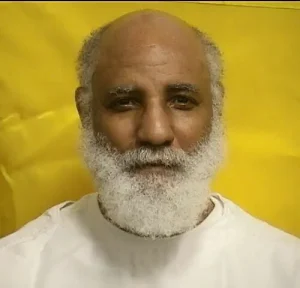Derrick Cook was sentenced to death by the State of Ohio for the murder of Frank Shorter
According to court documents Derrick Cook would force store owner Frank Shorter into an abandoned building where he would be murdered. Cook would rob the victim before fleeing
Derrick Cook would be arrested, convicted and sentenced to death
Derrick Cook Photos

Derrick Cook FAQ
Where Is Derrick Cook Now
Derrick Cook is incarcerated at Chillicothe Correctional Institution
Derrick Cook Case
n the morning of October 28, 1989, Frank Shorter, age sixty-eight, disappeared from the store he managed, Sullivan’s Clothing Store in Lockland, Ohio. Two people shopping nearby, Terry Teppe and Tereva Whitt, saw him at the store about 9:00 a.m. that day, but another shopper entering the store around noon did not see him in the store, and called the police. Shorter’s body was found in an abandoned building at 207 Seitz Street in Cincinnati on November 2, 1989, with a lethal gunshot wound to his head.
When Shorter was found, one of his pants pockets was turned inside out, and about $50 was missing from his wallet. Approximately $300 was missing from the cash register at the store. Items of clothing were also missing.
Shortly before 9:00 a.m. on October 28, 1989, Tereva Whitt saw a black man crossing the street outside Sullivan’s. She noticed brown spots on his face, and that he wore an Army-green full-length jacket. At about the same time, Everett Rasnick and Terry Teppe arrived in the vicinity of Sullivan’s. They both saw two black men outside the store. Teppe observed the face of the taller of the two men. The taller man wore what looked like a green Army fatigue jacket. Rasnick saw the men repeatedly during the span of five to eight minutes, and noted that the taller one wore a light green full-length coat.
On the same day, Brenda Tourney looked from a window of her apartment at 303 Seitz Street, Cincinnati, and saw an older white man in a blue suit, followed closely by a black man, walking toward a neighboring abandoned building. The black man was light-skinned and had splotches on his face. A few moments later, Tourney heard what sounded like a car backfiring.
Two persons were passing through the abandoned building on November 2, 1989, and one of them discovered the body of Shorter. The police were notified, and investigated the scene on November 3. They found Shorter lying on his back, his glasses still on his face, with a bullet hole under his chin. He had been bleeding from his nose and mouth, the blood flowing to the floor from his face. An autopsy revealed that Shorter had died from a bullet wound to the head from a gun fired at point-blank range.
Police had no leads in the case until January 11, 1990, when a Cincinnati police officer received a phone call from an individual demanding money for the murder weapon. The next day, the officer received another call, which he taped. The caller said that he had left a bullet from the murder weapon on top of a sign at a Burger King. The officer retrieved the bullet, which was too damaged for police to determine whether it matched the one that killed Shorter. Later, the caller left another bullet in the coin return of a phone booth, and called a different officer with this information. This call, too, was recorded. This bullet matched the one taken from Shorter’s body.
On January 18, 1990, Shorter’s widow, Alma Shorter, received a telephone call from a person wanting reward money for the murder weapon. A subsequent call came at approximately 8:30 p.m. on January 19. Shorter’s son-in-law kept the caller on the line for several minutes, and the call was recorded and traced to a telephone booth at 1601 Main Street. The information was dispatched to two Cincinnati policemen, Officers Terry Meiners and Dennis Luken, who proceeded immediately to that location. Officer Meiners saw defendant, Derrick Cook, leaving the phone booth, wearing an Army-green coat. A woman using an adjacent phone booth identified defendant as having just used the other booth. Officer Lucian Guy, who had been investigating the case, arrived minutes later. Police subsequently searched defendant and found a list of telephone numbers on him. Two of the numbers on this list were connected to the booths where the bullets were found. Cook was placed under arrest.
Defendant (Derrick Cook) was placed in a lineup and identified by Whitt, Tourney, Rasnick and Teppe. All four identified defendant in the courtroom at his trial.
Further evidence was introduced at trial. Sheila Valerius, defendant’s employer, identified defendant’s voice from the recorded phone conversations. Defendant had asked Valerius for a pay advance on October 27, 1989, and she turned him down. Sometime between October 18 and October 31, defendant asked a fellow employee where defendant could obtain a gun. Valerius asked defendant about this conversation and he admitted it. Defendant made a $243.42 payment on his car on October 28, 1989, the day of the murder.
On February 21, 1990, the Hamilton County Grand Jury returned an indictment against defendant, charging him with two counts of aggravated murder with death-penalty specifications, aggravated robbery, and kidnapping. Other specifications included prior conviction and possession of a firearm. Defendant pled not guilty to all charges on February 23, 1990.
A jury found defendant guilty on all counts and specifications on August 17, 1990. Following a mitigation hearing at which neither defendant nor the state produced any further evidence, the jury recommended the sentence of death. The trial judge sentenced defendant to death on the aggravated-murder counts, and two consecutive sentences of fifteen to twenty-five years on the aggravated robbery and kidnapping counts. He received an additional three years for the gun specification. The court of appeals affirmed appellant’s convictions and the death penalty.







